Big Data Opportunities and Challenges
VerifiedAdded on 2023/04/21
|18
|1144
|453
Presentation
AI Summary
This presentation discusses the opportunities and challenges of big data in different industries. It covers the benefits of using big data in healthcare and the food industry, as well as the technologies and techniques used in big data analytics. The challenges of data growth and recruiting big data experts are also addressed.
Contribute Materials
Your contribution can guide someone’s learning journey. Share your
documents today.

IT
Secure Best Marks with AI Grader
Need help grading? Try our AI Grader for instant feedback on your assignments.
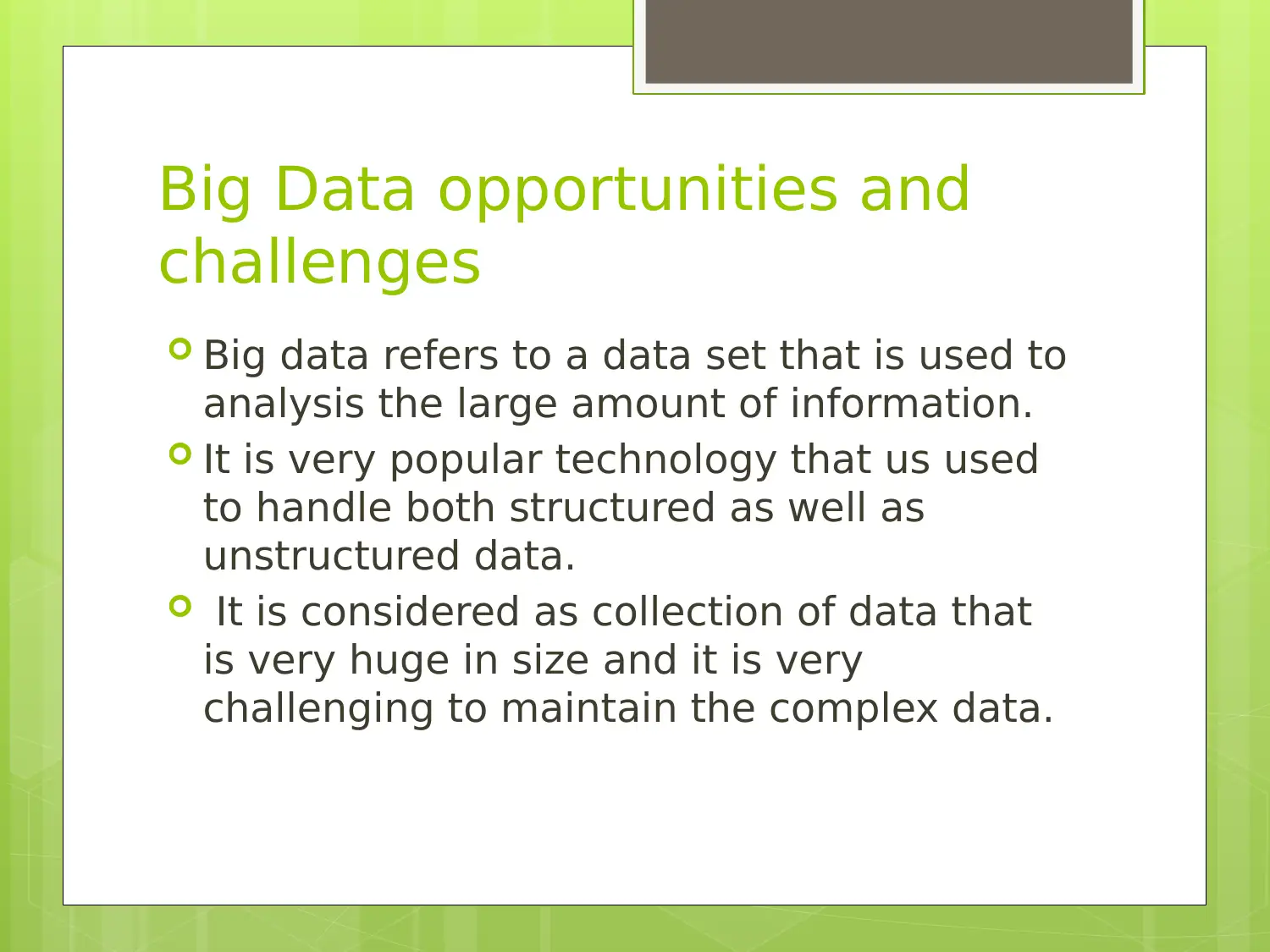
Big Data opportunities and
challenges
Big data refers to a data set that is used to
analysis the large amount of information.
It is very popular technology that us used
to handle both structured as well as
unstructured data.
It is considered as collection of data that
is very huge in size and it is very
challenging to maintain the complex data.
challenges
Big data refers to a data set that is used to
analysis the large amount of information.
It is very popular technology that us used
to handle both structured as well as
unstructured data.
It is considered as collection of data that
is very huge in size and it is very
challenging to maintain the complex data.
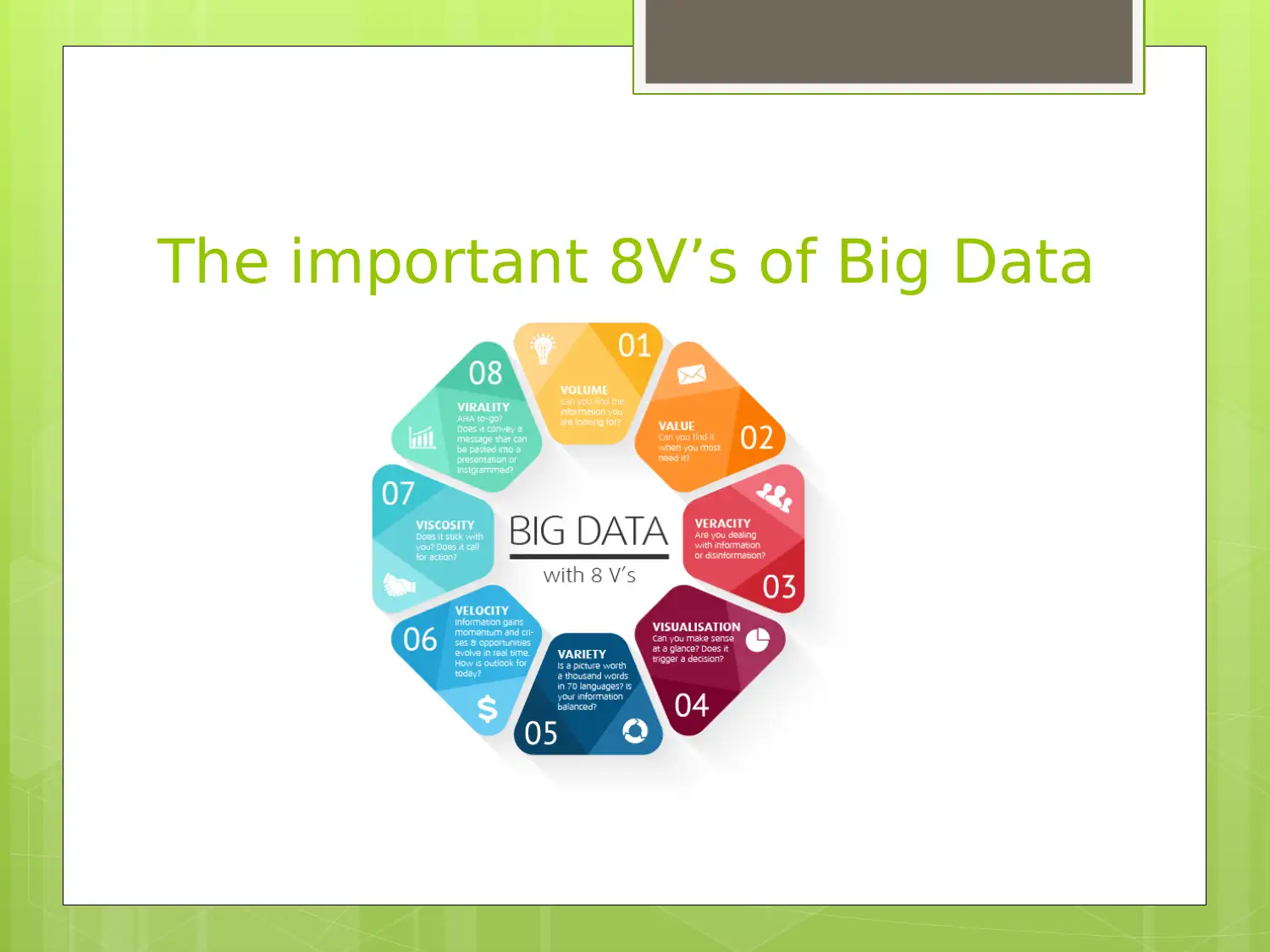
The important 8V’s of Big Data
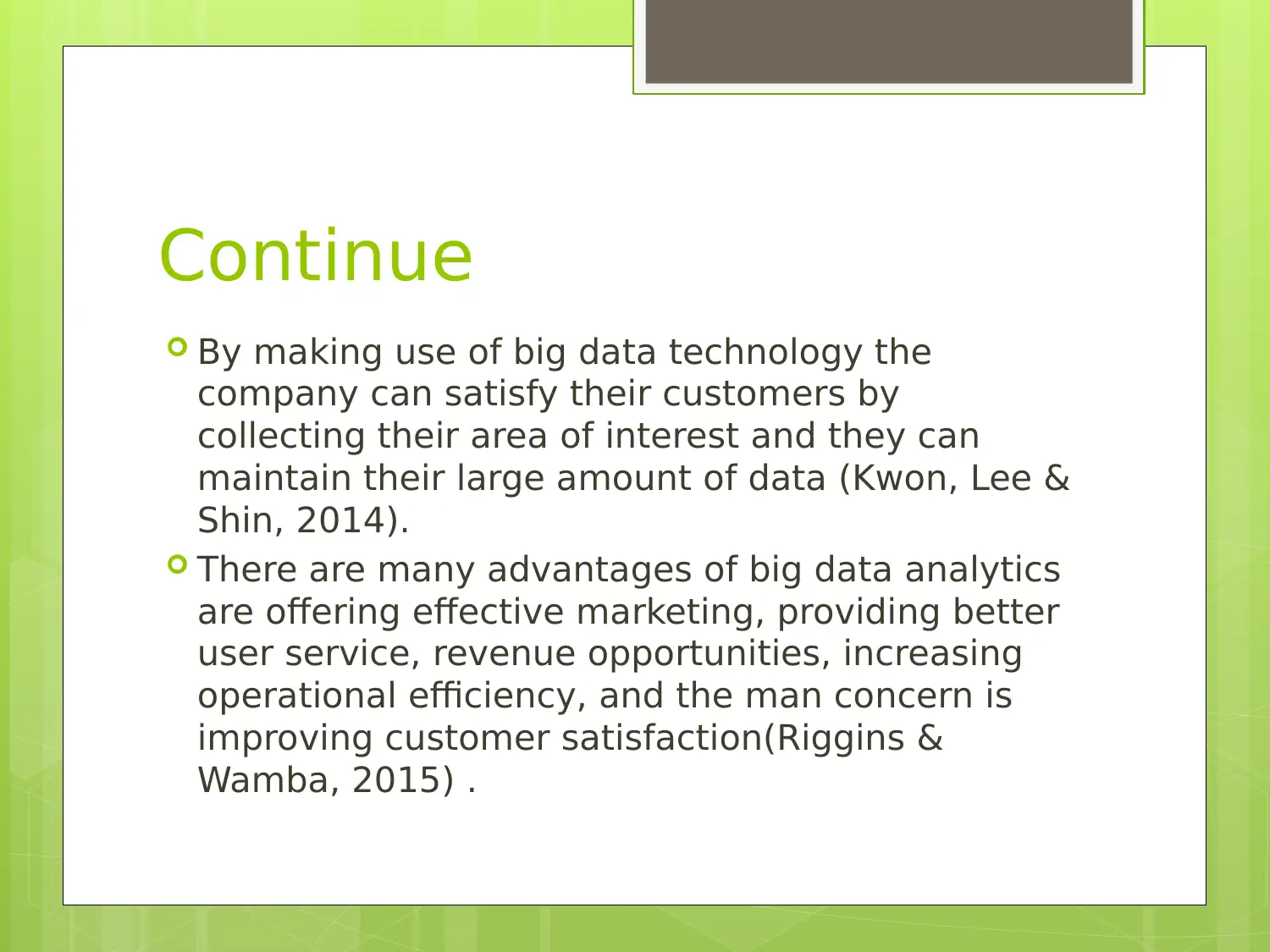
Continue
By making use of big data technology the
company can satisfy their customers by
collecting their area of interest and they can
maintain their large amount of data (Kwon, Lee &
Shin, 2014).
There are many advantages of big data analytics
are offering effective marketing, providing better
user service, revenue opportunities, increasing
operational efficiency, and the man concern is
improving customer satisfaction(Riggins &
Wamba, 2015) .
By making use of big data technology the
company can satisfy their customers by
collecting their area of interest and they can
maintain their large amount of data (Kwon, Lee &
Shin, 2014).
There are many advantages of big data analytics
are offering effective marketing, providing better
user service, revenue opportunities, increasing
operational efficiency, and the man concern is
improving customer satisfaction(Riggins &
Wamba, 2015) .
Secure Best Marks with AI Grader
Need help grading? Try our AI Grader for instant feedback on your assignments.
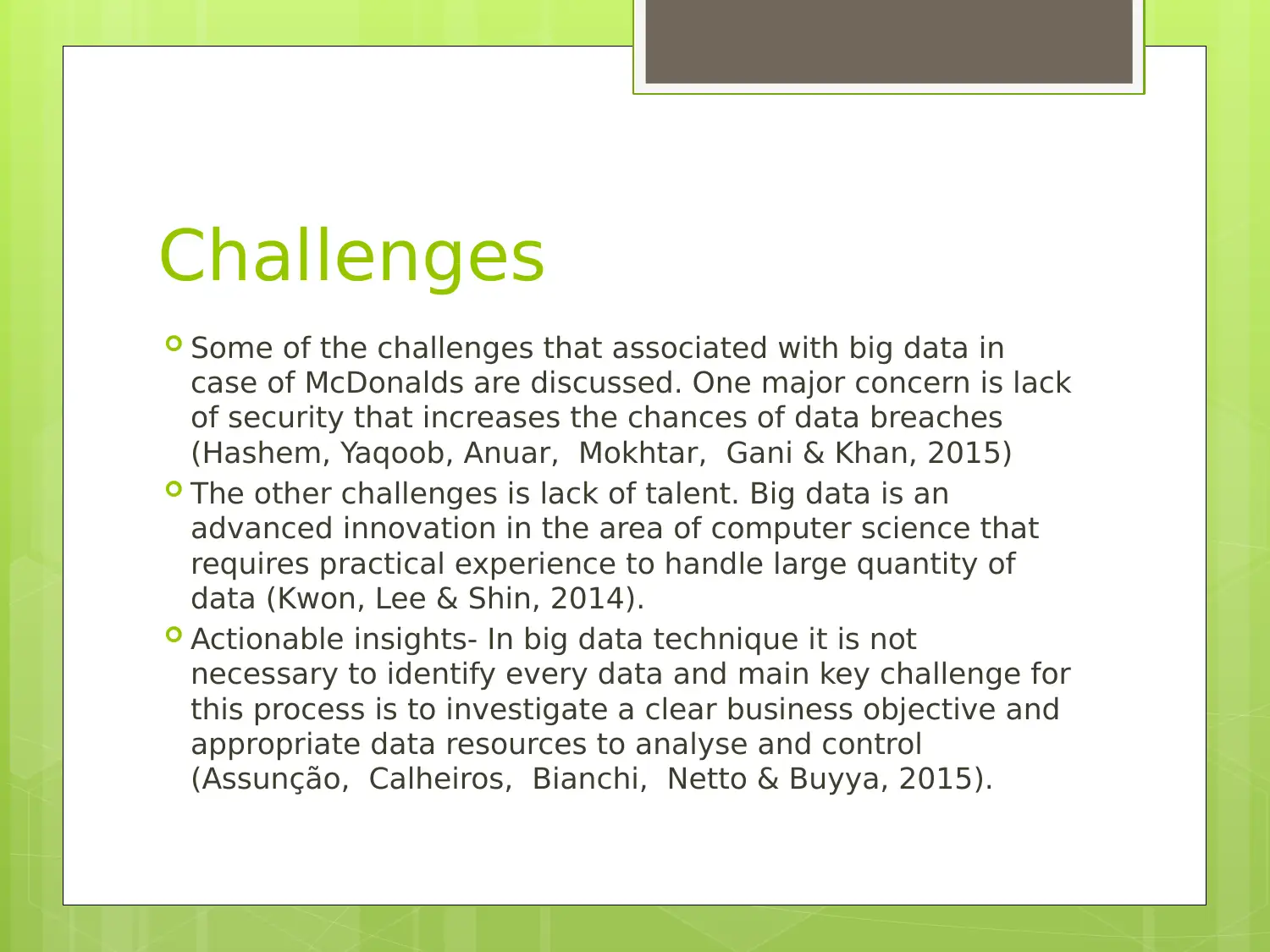
Challenges
Some of the challenges that associated with big data in
case of McDonalds are discussed. One major concern is lack
of security that increases the chances of data breaches
(Hashem, Yaqoob, Anuar, Mokhtar, Gani & Khan, 2015)
The other challenges is lack of talent. Big data is an
advanced innovation in the area of computer science that
requires practical experience to handle large quantity of
data (Kwon, Lee & Shin, 2014).
Actionable insights- In big data technique it is not
necessary to identify every data and main key challenge for
this process is to investigate a clear business objective and
appropriate data resources to analyse and control
(Assunção, Calheiros, Bianchi, Netto & Buyya, 2015).
Some of the challenges that associated with big data in
case of McDonalds are discussed. One major concern is lack
of security that increases the chances of data breaches
(Hashem, Yaqoob, Anuar, Mokhtar, Gani & Khan, 2015)
The other challenges is lack of talent. Big data is an
advanced innovation in the area of computer science that
requires practical experience to handle large quantity of
data (Kwon, Lee & Shin, 2014).
Actionable insights- In big data technique it is not
necessary to identify every data and main key challenge for
this process is to investigate a clear business objective and
appropriate data resources to analyse and control
(Assunção, Calheiros, Bianchi, Netto & Buyya, 2015).

Continue
Thus, the major drawbacks that are
observed in food industry are dealing
with the data growth. Additionally, it is
also difficult to generate the insights in
timely manner (Bates, Saria, Ohno-
Machado, Shah & Escobar, 2014). It is
challenging to recruit the big data
expert from the market
Thus, the major drawbacks that are
observed in food industry are dealing
with the data growth. Additionally, it is
also difficult to generate the insights in
timely manner (Bates, Saria, Ohno-
Machado, Shah & Escobar, 2014). It is
challenging to recruit the big data
expert from the market
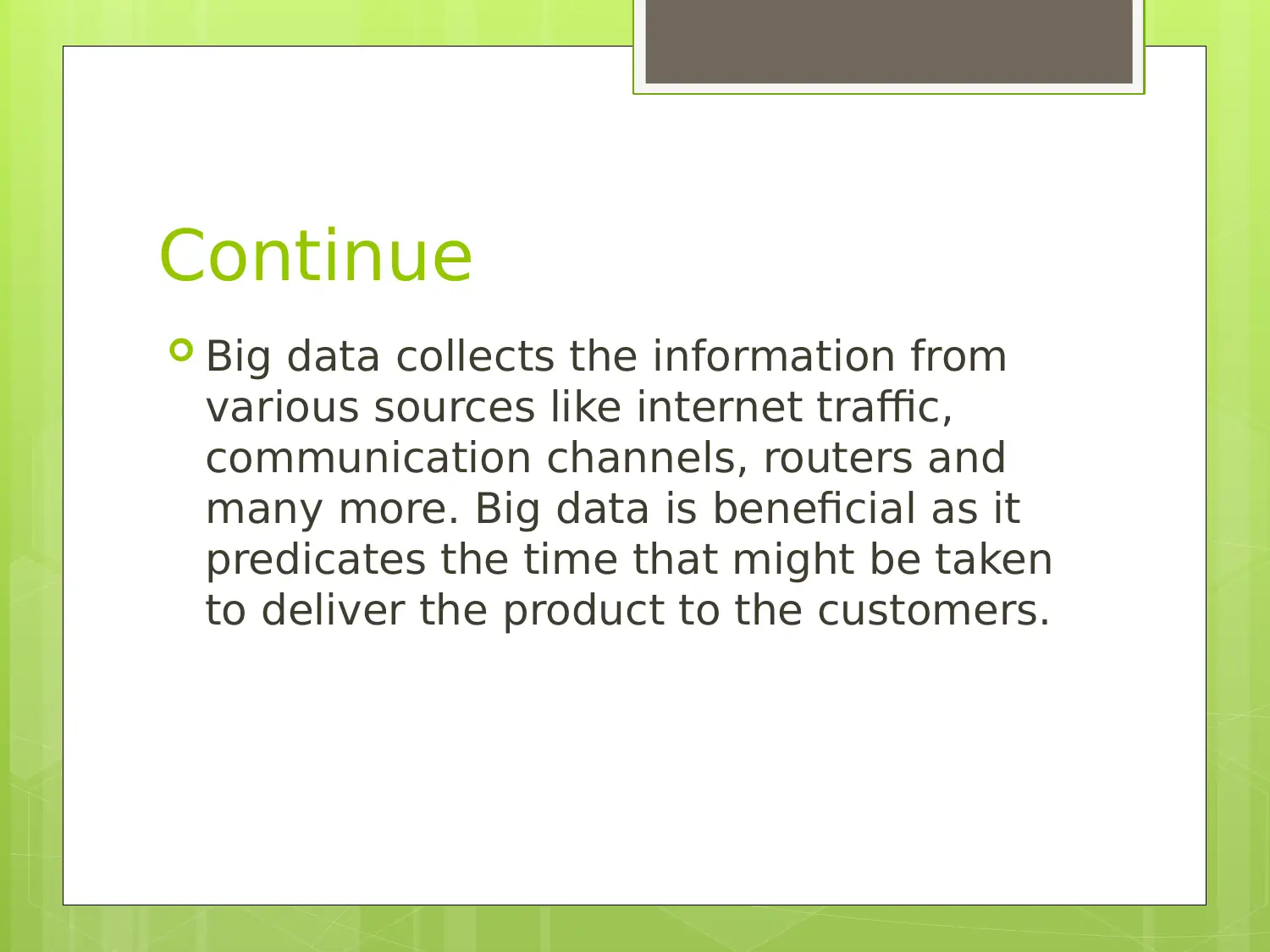
Continue
Big data collects the information from
various sources like internet traffic,
communication channels, routers and
many more. Big data is beneficial as it
predicates the time that might be taken
to deliver the product to the customers.
Big data collects the information from
various sources like internet traffic,
communication channels, routers and
many more. Big data is beneficial as it
predicates the time that might be taken
to deliver the product to the customers.
Paraphrase This Document
Need a fresh take? Get an instant paraphrase of this document with our AI Paraphraser
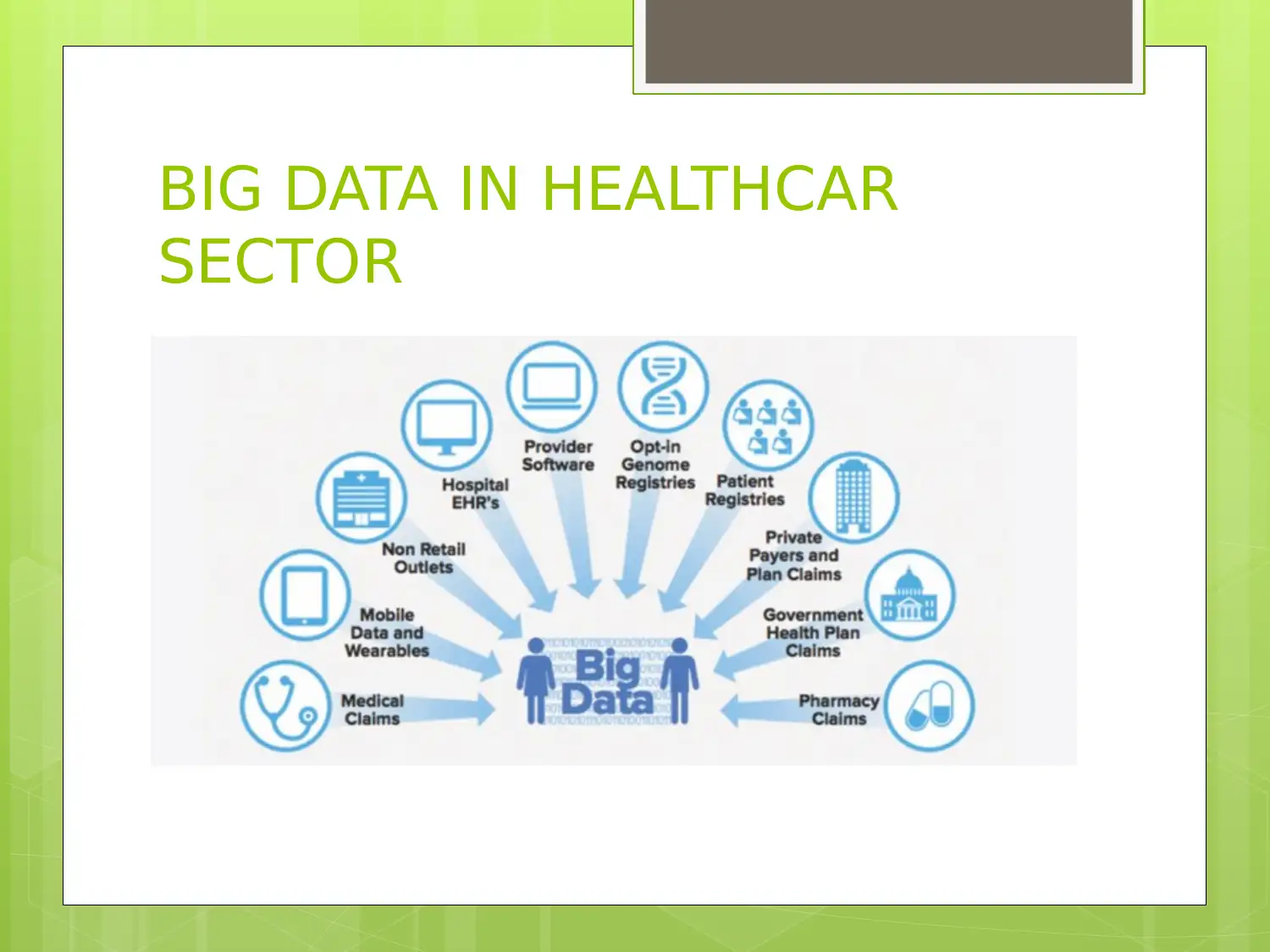
BIG DATA IN HEALTHCAR
SECTOR
SECTOR
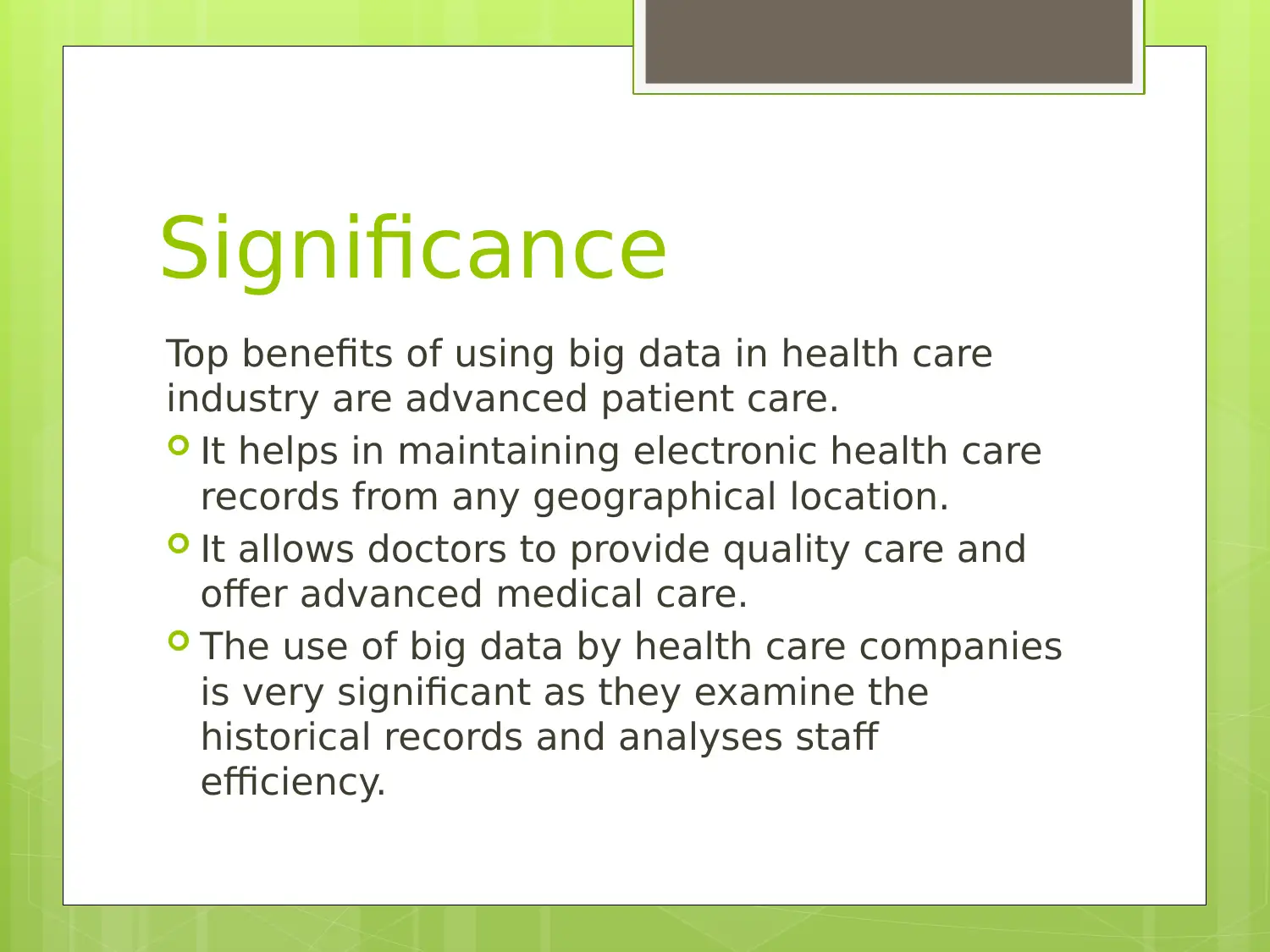
Significance
Top benefits of using big data in health care
industry are advanced patient care.
It helps in maintaining electronic health care
records from any geographical location.
It allows doctors to provide quality care and
offer advanced medical care.
The use of big data by health care companies
is very significant as they examine the
historical records and analyses staff
efficiency.
Top benefits of using big data in health care
industry are advanced patient care.
It helps in maintaining electronic health care
records from any geographical location.
It allows doctors to provide quality care and
offer advanced medical care.
The use of big data by health care companies
is very significant as they examine the
historical records and analyses staff
efficiency.

Continue
The application of big data in healthcare has
various life saving benefits.
The treatment plans are modelled and modified
according to the analyses of information.
They make use of data driven approach to track
the inventory and empower the ways in which
patients’ health could be enhanced.
Doctors are able to track the past performance of
patient and then prevention strategies are
developed.
The application of big data in healthcare has
various life saving benefits.
The treatment plans are modelled and modified
according to the analyses of information.
They make use of data driven approach to track
the inventory and empower the ways in which
patients’ health could be enhanced.
Doctors are able to track the past performance of
patient and then prevention strategies are
developed.
Secure Best Marks with AI Grader
Need help grading? Try our AI Grader for instant feedback on your assignments.
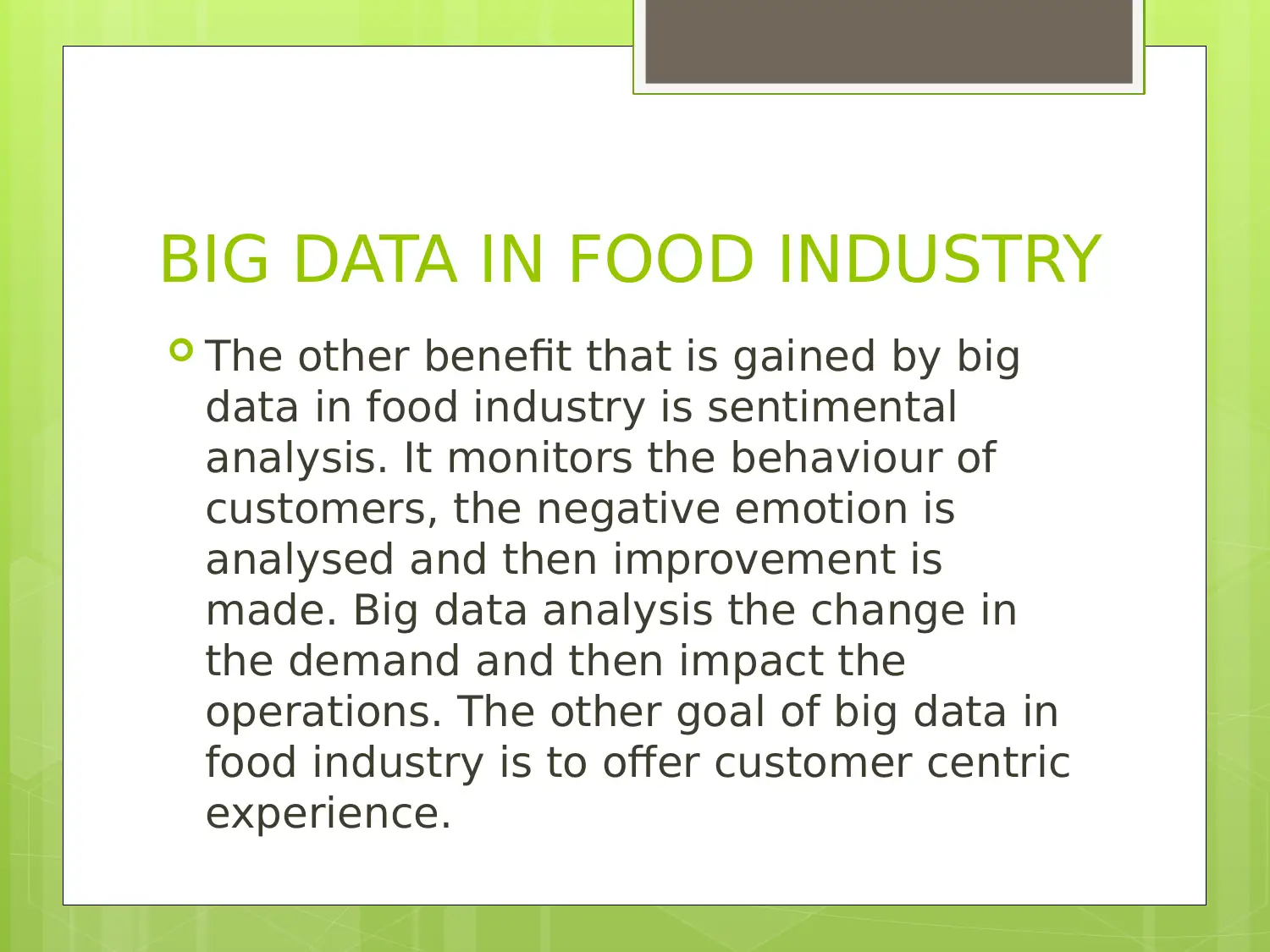
BIG DATA IN FOOD INDUSTRY
The other benefit that is gained by big
data in food industry is sentimental
analysis. It monitors the behaviour of
customers, the negative emotion is
analysed and then improvement is
made. Big data analysis the change in
the demand and then impact the
operations. The other goal of big data in
food industry is to offer customer centric
experience.
The other benefit that is gained by big
data in food industry is sentimental
analysis. It monitors the behaviour of
customers, the negative emotion is
analysed and then improvement is
made. Big data analysis the change in
the demand and then impact the
operations. The other goal of big data in
food industry is to offer customer centric
experience.

Challenges in food industry
Thus, the major drawbacks that are
observed in food industry are dealing with
the data growth. Additionally, it is also
difficult to generate the insights in timely
manner. It is challenging to recruit the big
data expert from the market
Thus, the major drawbacks that are
observed in food industry are dealing with
the data growth. Additionally, it is also
difficult to generate the insights in timely
manner. It is challenging to recruit the big
data expert from the market
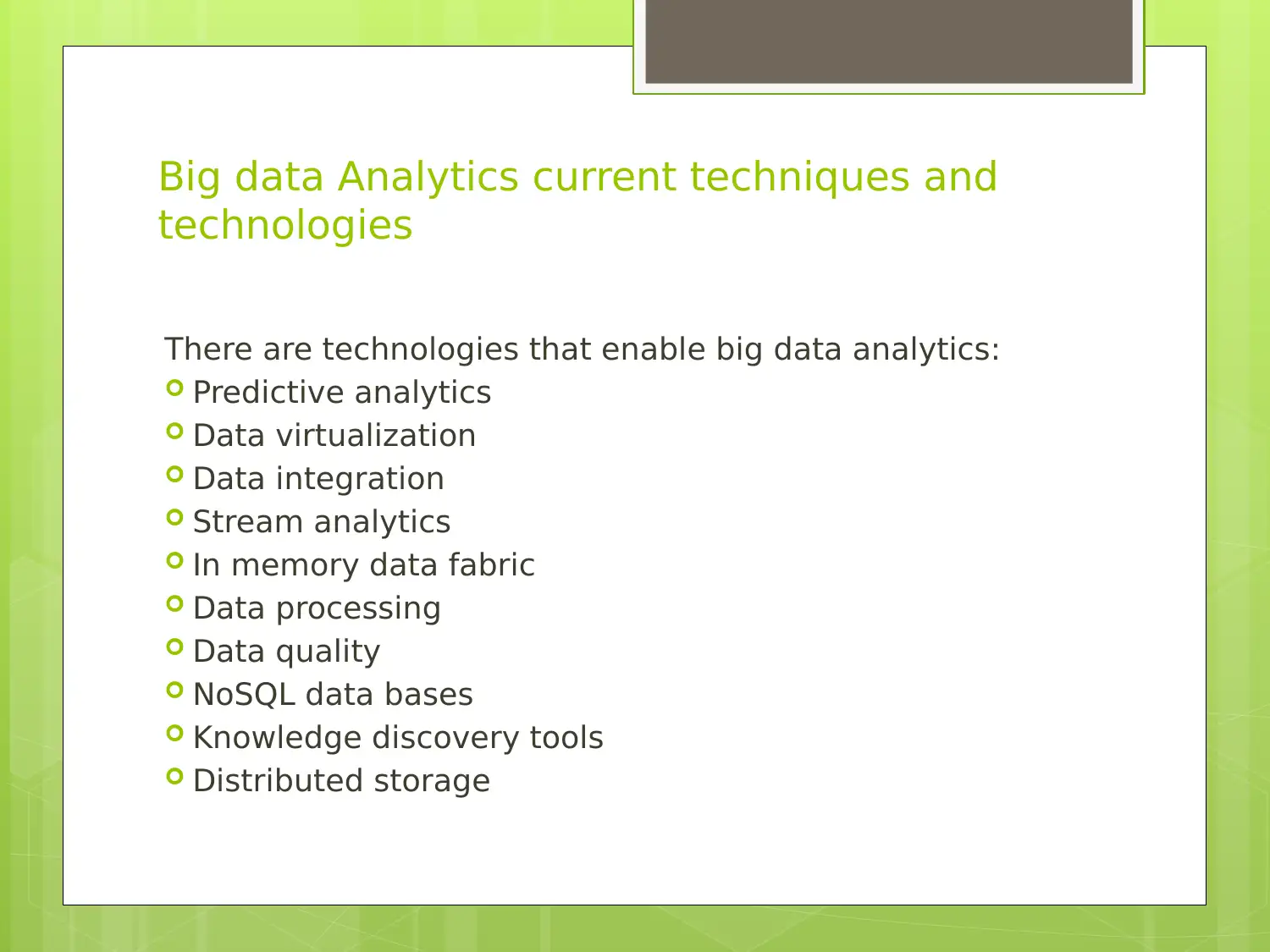
Big data Analytics current techniques and
technologies
There are technologies that enable big data analytics:
Predictive analytics
Data virtualization
Data integration
Stream analytics
In memory data fabric
Data processing
Data quality
NoSQL data bases
Knowledge discovery tools
Distributed storage
technologies
There are technologies that enable big data analytics:
Predictive analytics
Data virtualization
Data integration
Stream analytics
In memory data fabric
Data processing
Data quality
NoSQL data bases
Knowledge discovery tools
Distributed storage
Paraphrase This Document
Need a fresh take? Get an instant paraphrase of this document with our AI Paraphraser
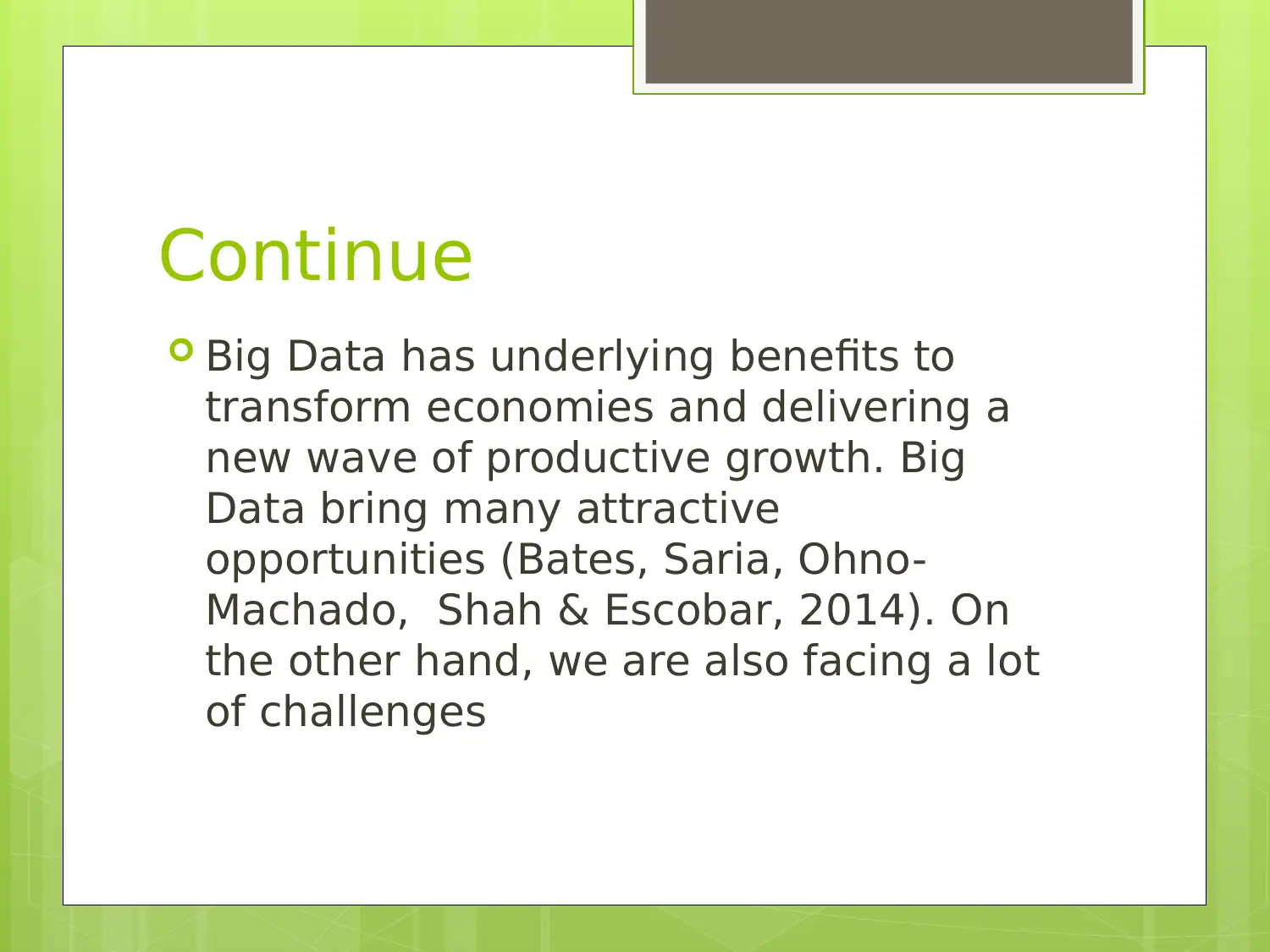
Continue
Big Data has underlying benefits to
transform economies and delivering a
new wave of productive growth. Big
Data bring many attractive
opportunities (Bates, Saria, Ohno-
Machado, Shah & Escobar, 2014). On
the other hand, we are also facing a lot
of challenges
Big Data has underlying benefits to
transform economies and delivering a
new wave of productive growth. Big
Data bring many attractive
opportunities (Bates, Saria, Ohno-
Machado, Shah & Escobar, 2014). On
the other hand, we are also facing a lot
of challenges
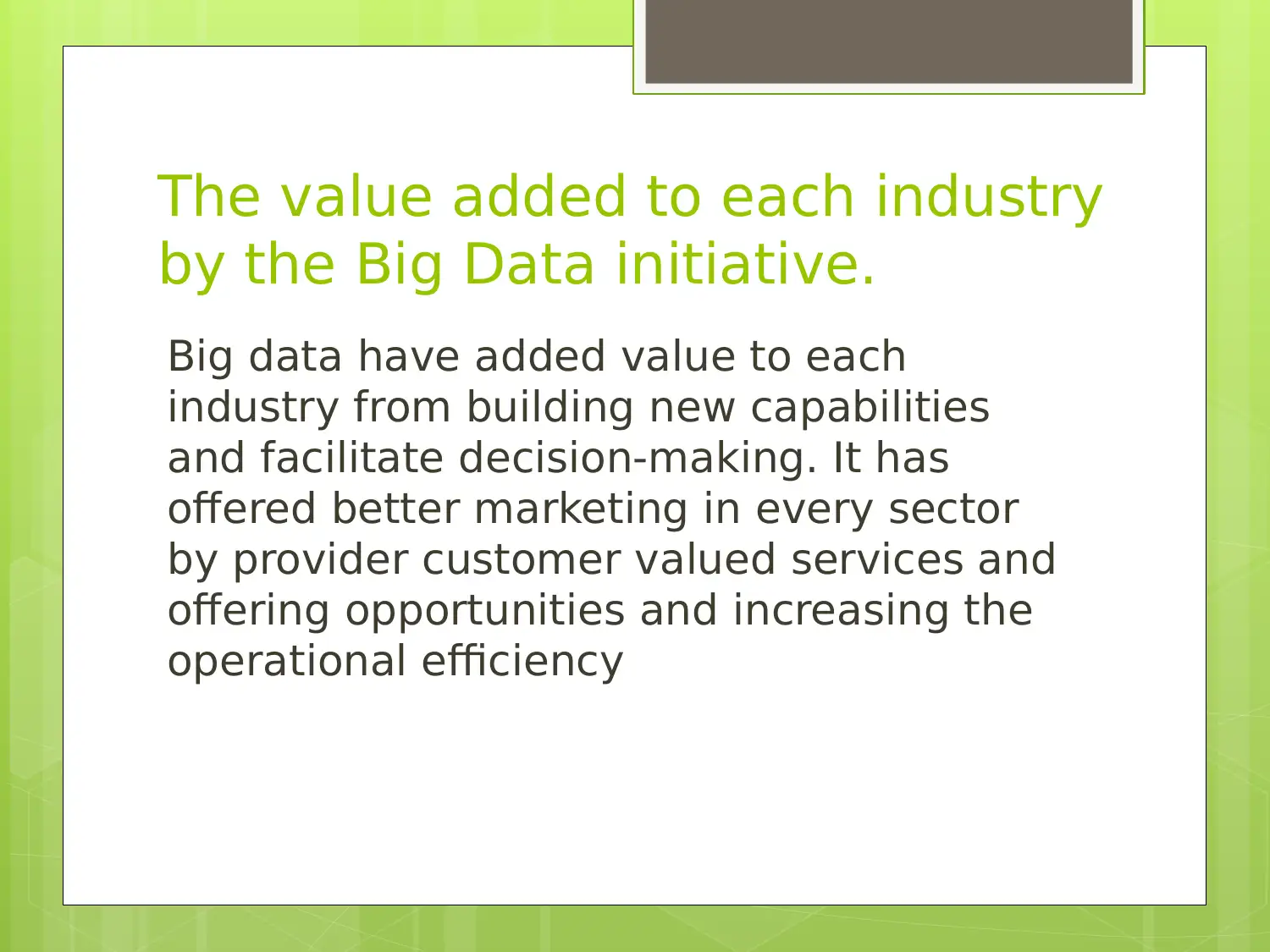
The value added to each industry
by the Big Data initiative.
Big data have added value to each
industry from building new capabilities
and facilitate decision-making. It has
offered better marketing in every sector
by provider customer valued services and
offering opportunities and increasing the
operational efficiency
by the Big Data initiative.
Big data have added value to each
industry from building new capabilities
and facilitate decision-making. It has
offered better marketing in every sector
by provider customer valued services and
offering opportunities and increasing the
operational efficiency
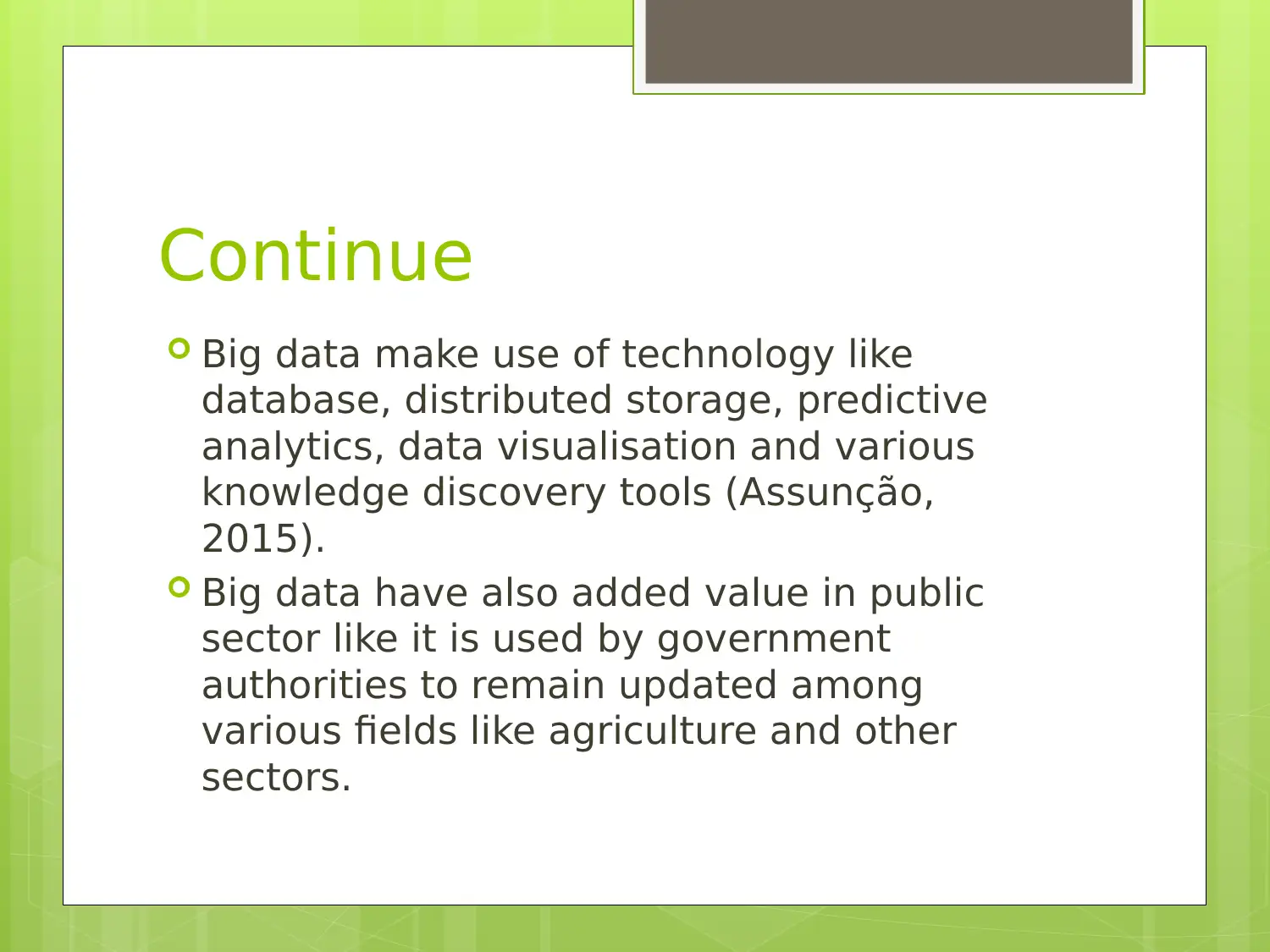
Continue
Big data make use of technology like
database, distributed storage, predictive
analytics, data visualisation and various
knowledge discovery tools (Assunção,
2015).
Big data have also added value in public
sector like it is used by government
authorities to remain updated among
various fields like agriculture and other
sectors.
Big data make use of technology like
database, distributed storage, predictive
analytics, data visualisation and various
knowledge discovery tools (Assunção,
2015).
Big data have also added value in public
sector like it is used by government
authorities to remain updated among
various fields like agriculture and other
sectors.
Secure Best Marks with AI Grader
Need help grading? Try our AI Grader for instant feedback on your assignments.
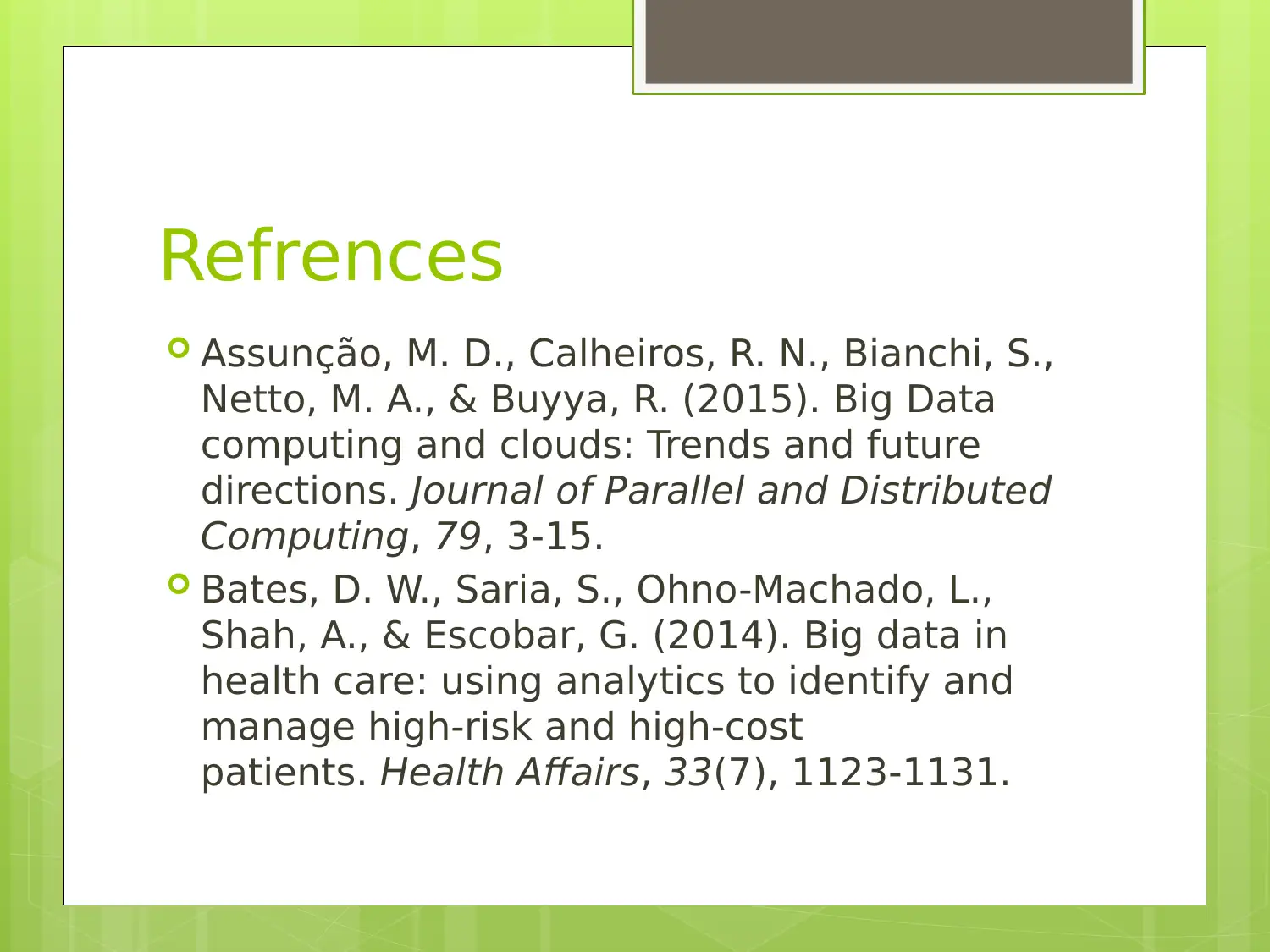
Refrences
Assunção, M. D., Calheiros, R. N., Bianchi, S.,
Netto, M. A., & Buyya, R. (2015). Big Data
computing and clouds: Trends and future
directions. Journal of Parallel and Distributed
Computing, 79, 3-15.
Bates, D. W., Saria, S., Ohno-Machado, L.,
Shah, A., & Escobar, G. (2014). Big data in
health care: using analytics to identify and
manage high-risk and high-cost
patients. Health Affairs, 33(7), 1123-1131.
Assunção, M. D., Calheiros, R. N., Bianchi, S.,
Netto, M. A., & Buyya, R. (2015). Big Data
computing and clouds: Trends and future
directions. Journal of Parallel and Distributed
Computing, 79, 3-15.
Bates, D. W., Saria, S., Ohno-Machado, L.,
Shah, A., & Escobar, G. (2014). Big data in
health care: using analytics to identify and
manage high-risk and high-cost
patients. Health Affairs, 33(7), 1123-1131.

Hashem, I. A. T., Yaqoob, I., Anuar, N. B., Mokhtar, S., Gani, A., &
Khan, S. U. (2015). The rise of “big data” on cloud computing:
Review and open research issues. Information systems, 47, 98-115.
Kwon, O., Lee, N., & Shin, B. (2014). Data quality management,
data usage experience and acquisition intention of big data
analytics. International Journal of Information Management, 34(3),
387-394.
Riggins, F. J., & Wamba, S. F. (2015, January). Research directions
on the adoption, usage, and impact of the internet of things through
the use of big data analytics. In System Sciences (HICSS), 2015
48th Hawaii International Conference on (pp. 1531-1540). IEEE.
Khan, S. U. (2015). The rise of “big data” on cloud computing:
Review and open research issues. Information systems, 47, 98-115.
Kwon, O., Lee, N., & Shin, B. (2014). Data quality management,
data usage experience and acquisition intention of big data
analytics. International Journal of Information Management, 34(3),
387-394.
Riggins, F. J., & Wamba, S. F. (2015, January). Research directions
on the adoption, usage, and impact of the internet of things through
the use of big data analytics. In System Sciences (HICSS), 2015
48th Hawaii International Conference on (pp. 1531-1540). IEEE.
1 out of 18
Related Documents
Your All-in-One AI-Powered Toolkit for Academic Success.
+13062052269
info@desklib.com
Available 24*7 on WhatsApp / Email
![[object Object]](/_next/static/media/star-bottom.7253800d.svg)
Unlock your academic potential
© 2024 | Zucol Services PVT LTD | All rights reserved.





